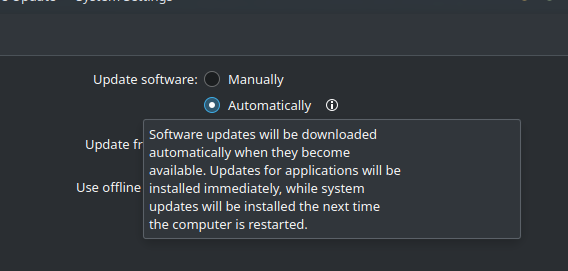#1 is just not being the default for 99% of devices. If someone gets a new computer, why would they go through the effort of installing a new os when the one it comes with works fine? Hell, I bet at least 50% of people in the market for a pc don’t even know what an OS is.
I bet at least 50% of people in the market for a pc don’t even know what an OS is.
70%*
Agreed. Android and chrome os are used happily by 10s of millions without any idea it’s a Linux distro
Which actually means Linux is being successfully adopted by the general public in a similar way to windows as a general use system that doesn’t require a lot of technical knowledge.
Fully customizable distress will never be popular with the general public. They want systems that just do the general stuff and have it work automatically.
I bet if small, cheap netbooks came out running mint or fedora or something people wouldn’t even or know or care that it was Linux.
In middle school I had a USB drive with Linux Mint installed on it which I was using on school PCs. We only used those PCs for internet browsing and office. Not a single soul noticed it wasn’t Windows. Teacher only noticed 2 differences, “You have different version of Office installed here.” and also gave me a note for “Changing wallpaper” which was strictly prohibited for some reason.
which was strictly prohibited
It was probably due to some goober like me changing it to Scarlett Johansson’s bikini pics. I’m sorry.
So… the Steamdeck?
Absolutely. In fact i think everyone is hoping steam os will be the distro to make the big push onto desktop because of the gaming and another just works kind of interface
Indeed, many Netbooks come with a firmware dual boot. Besides the crappy Windows lite edition, there’s a tiny instant-on Linux too. Most people don’t use that, but it’s there.
Indeed, many Netbooks come with a firmware dual boot. Besides the crappy Windows lite edition, there’s a tiny instant-on Linux too. Most people don’t use that, but it’s there.
Of course they know what an OS is. There’s only two of them: Apple and Microsoft.
my first thought actually pointed to common OS on work devices, being Windows i’d assume a majority of the time, i’d imagine a large portion of the older population were introduced to computers in a workplace setting. But your answer makes a bit more sense.
New user: I have a problem 😊
Everyone:👍
- are you on xorg or wayland?
- pulseaudio or pipewire?
- what WM/DE are you using?
- amd or nvidia?
- what distro?
- systemd?
New user: Nevermind 😮💨
if a new user is using a distro that doesn’t use systemd they fell for a meme
if a new user is using a distro that doesn’t use systemd they fell for a meme
Or they hate fridge art like systemd and are on something like PCLinuxOS or Alpine.
That’s what I mean though, why would a new user be running alpine as a desktop os?
At this point, my biggest dream is that these ‘new user’ distros used only Wayland, Pipewire, Systemd and Flatpaks simply to simplify things. Hopefully we’re less than 2024 away from NoVideo Wayland support.
Also as soon as XFCE releases their Wayland support, that soon it’ll become the most famous DE choice of Mint.
What I am really happy is to see how well supported Pipewire already is. Pipewire has never showed any problem in the new installs for me.
The problem with that is most major distros market themselves as “new user” distros to some extent though. Noob-friendly, out-of-the-box, easy, etc are all distro-marketing buzz-words that mean nothing.
You can’t expect them to only use Wayland, Pipewire, Systemd, and Flatpaks because that dream requires every distro to use Wayland, Pipewire, Systemd, and Flatpaks, which will never be reality.
Most distros will probably eventually adopt these tools, but there won’t be a sudden shift. It will be gradual.
Well, for Pipewire it’s the apps which needs to adjust at this point. Only thing missing currently is the Wayland but it’s coming. Making Linux less fragmented (read: confusing), the more new users will give a try.
pipewire seems ready for primetime but I’m more dubious about Wayland. For instance KDE appears to still be a bit flaky and sway still works poorly under Nvidia and will never have proper mixed DPI for xwayland apps. Still seems like a tradeoff vs X which doesn’t require a compromise. XFCE is roughly 10% of Mint users. Mint users are unlikely to switch because of wayland support
So … basically Pop!_OS.
That’s what I’m using now, and it’s what I’d recommend for most desktop users. I’ve been using Linux systems on-and-off since before kernel version 1.0: Slackware, then Debian, then Ubuntu, then Mint, then Pop.
(Admittedly, my use cases are pretty simple: a terminal, a browser, Signal, VLC, and Steam.)
Pretty much. Pop is my go-to recommendation for pretty much anyone these days. It’s so well polished and just easy.
This PopOs ?
This whole series triggered me so hard. They went out of their way to test it under the worst possible conditions.
- last at night
- setting a goal with a deadline/time constraints for first run
- not stopping and reading or thinking, just assuming away
- copy paste from google frsit thing that looks vagualy right
- tunnel vission
- not resources like Emily, ensuring they make big mistakes
Then they follow up with hypocrisy of this shit, after going on and on about UI not being right or hard to use for the end user.
Here is an alternative Piped link(s): https://piped.video/watch?v=smd8cTFchF4
Piped is a privacy-respecting open-source alternative frontend to YouTube.
I’m open-source, check me out at GitHub.
Yes, that pop os. As luck would have it, Linus installed it during a very brief period where the steam package in their repo was broken. This is not a common occurrence, and I have never heard of it happening before or since.
Systemd
Fridge art. Fuck, they MAYBE have nfsroot working. MAYBE. After a decade of fucking around, when it was available for ages. The number of bags on the side of lennart’s piece of crap, just to reinvent the wheels we had before, is absolutely ridiculous.
and Flatpaks
… break single source of truth for as-built information and current software manifest. This kills validation, which dissolves certainty on consistency, then repeatability. And given the state of the software load exported to management tools is NOT the flatpak source of truth, you now have a false negative on the ‘installation’ of a flatpak resource when checking it via management.
Oh. That needs to be on the interview questions.
Gonna be honest with you I’m an intermediate user and understood jack shit of what you just said. A beginner and average user would have probably been scared off by Linux by this point rewding this.
A beginner and average user would have probably been scared off by Linux by this point rewding this.
Maybe thats what he/she was trying to achieve.
Doing tech support, I encountered this attitude. People like that are nearly impossible to help. “Why can’t you just fix it!” The true answer never given is that your problem is probably something stupid you are doing, like trying to make a phone call by physically shoving the phone entirely up your asshole, and until I run through some common problems and ask some questions, I won’t be able to tell you to have your significant other get the salad tongs and pull it out of your rear and then go over “dialing.”
People mostly need to be willing to gather detailed system info with Inxi and share it.
I’ll have you know I get better reception when it’s up my ass!
No. That’s the support job to figure out the problem of the user. It is not the user’s job to figure out the support problems.
I work in support, so I know what I’m talking about. Unfortunately most computer guys are elitist assholes who can’t understand a user doesn’t have their knowledge or even the will to understand why this shitty tech is not working.
Free open source software projects you don’t pay for don’t have paid support. If you talk to a fellow user it IS your job to figure out your problem. if you don’t have the will to understand anything you ought to buy a support contract.
I don’t disagree with you, but to answer OP’s question, I think this right here is the problem. I love Linux for the same reason I love building my own PCs and working on my own car. For most people that don’t want to tinker, though, they’re looking for something that “just works” and can be fixed by someone else when it breaks.
It’s such a privileged attitude, though. One CAN get paid support, but they don’t need it if they’re just a bit patient and willing to follow instructions. If you don’t want to pay, don’t expect someone else to deal with your bullshit.
(I’m not saying this to you, but to anyone who has this attitude.)
It case the subject wasn’t entirely clear in my prior post I agree with you, and that is exactly what I was trying to say. You the user of a foss project, aren’t a customer unless you give someone money. It IS your job to figure out your own issues. If you ask for help from your fellow users and they graciously provide you help then this is a gift you should appreciate. Because the person isn’t an expert on that topic in the employ of the creator, they might not know everything, nor do they have the infinite patience imparted by being paid by the hour to provide you help. They have their own shit to do. Treating them with entitlement and contempt like people treat support will burn these sorts of folks out, and they are far from an infinite resource. If you want a paid support relationship instead of treating the open source community as free help whose time you are entitled to, you ought to actually pay someone to do that job.
Pay for support then. Companies like Canonical and Redhat will be happy to take your money.
So you want them to provide answers by using magic? If you seek support for any software, open source or otherwise, you’ll need to tell them version, build number etc. Why do you think Linux will be any different?
Because people can already barely provide this level of information for a Windows device. Most of these words look like technobabble to non-tech-enthusiasts
Of course the words will be different. They aren’t hard words. And they can be answered very easily. In fact, most forums ask to include an output of something like
inxi -Fazywith every question, thus eliminating the need for all of these things.For more niche problems, people might ask for more specific information. But most of the time, they’ll tell you exactly what to run to get that information.
You know what’s the Windows alternative for this? Most of the time, nothing. You need to reinstall Windows. Mac is similar, except you need to have it replaced. You actually CAN repair Linux. That’s the difference.
Why don’t you magically have a magic button that magically fixes everything with no effort of my own? That’s stupid, I think I will go on social media and repeatedly tell everyone that Linux is bad actually
Based on my tests on my family and friends, the main problem is tech support. Most geeks seem to assume other people want the same things than themselves (privacy, freedom, etc). Well, they don’t. They want a computer that just works.
Overall when using Linux, people actually don’t need much tech support, but they need it. My father put it really well by saying: “the best OS is the one of your neighbor.”
I apply few rules:
-
The deal with my family and friends is simple: you want tech support from me ? ok, then I’m going to pick your computer (usually old Lenovo Thinkpads bought on Ebay at ~300€) and I’m going to install Linux on it.
-
I’m not shy. I ask them if they want me to have remote access to their computer. If they accept, I install a Meshcentral agent. Thing is, on other OS, they are already spied on by Google, Microsoft, Apple, etc. And most people think “they have nothing to hide”. Therefore why should they worry more about a family member or a friend than some unknown big company ? Fun fact, I’ve been really surprised by how easily people do accept that I keep a remote access on their computer: even people that are not family ! Pretty much everybody has gladly agreed up to now. (and God knows I’ve been really clear that I can access their computer whenever I want).
-
I install the system for them and I make the major updates for them. Therefore, if I have remote access to the system, I pick the distribution I’m the most at ease with (Debian). They just don’t care what actually runs on their computers.
-
When they have a problem, they call me after 8pm. With remote access, most problems are solved in a matter of minutes. Usually, they call me a few times the first days, and then I never hear from them anymore until the next major update.
So far, everybody seems really happy with this deal. And for those wondering, I can see in Meshcentral they really do use those computers :-P
When i told my dad i can install Rustdesk on his computer to do remote support (moved out), he asked me “does that mean you can look at my computer whenever you want?”. I’m really proud of him, he actually listened.
I think people sell themselves short with regards to having undue access to family members’ computers. If they’re willing to give it then you’ve clearly demonstrated that you’re trustworthy and haven’t given them reason to assume you’ll snoop or worse steal from them.
Are there any limitations to Meshcentral? I tried using Team Viewer and a few others when I was supporting family on Windows, and they all wanted to charge me after a while.
I self-host Meshcentral. I haven’t seen any limitation at all. I don’t know if there are limitations when you use meshcentral.com instead of self-hosting.
Thanks for replying :)
I’ll have a look into it, thanks. I pretty much only support my mother’s laptop outside of my house now, but I use NoMachine to sort out the home computers. As much as I like it, it can be a bit slow sometimes, and it’s always in the back of my mind that it’s going to lock me out like the others did.
Oh actually if you are worried about vendor lock-in: Meshcentral is opensource. So even if they decide to try something stupid, a fork would be likely to happen.
Wayland, unless something’s changed since the last time I tried it.
Try Anydesk, it’s very much like Teamviewer in many ways, though it’s not FOSS.
-
- Self updating without user interaction per default.
- Better support of codecs and drivers.
Linux does have better codecs and drivers than Windows for some stuff (Bluetooth for example), but it has worse codecs and drivers for some important proprietary hardware stuff (Nvidia for example)
Self updating without user interaction per default.
I think that this is a terrible idea, until a clear boundary is set between applications that can or cannot break the system. Updating flatpaks automatically might be fine, but updating everything is simply a recipe for disaster.
deleted by creator
See, that paragraph alone is too much for the majority of non-Linux users.
i believe fedora has this by default

- Installation process of Linux is complicated to an average Joe (Bootable USB/ISO file/Boot priority/format <- what are these scary terms?)
- Lack of availability of pre-installed Linux PCs at physical shops
- Lack of availability of industry-standard software
- Confusion for an average Joe due to excess choice of distros/application packaging format. Average people don’t want choices, they want to be guided.
- (Minor point) Most available guides for doing something heavily requires terminal usage which can be daunting to new users
Linux really isn’t ideal for anyone who isn’t already a tech enthusiast on some level. I recently did a fresh install of Kubuntu and after about a week, it prompted me that there were updates, so I clicked the notification and ran the updates, after which my BIOS could no longer detect the UEFI partition. I had to use a live usb to chroot into the system and repair it, as well as update grub, in order to fix it.
It’s fixable, but this is not something anyone who doesn’t already know what they’re doing can fix. I’ve had auto updates in the past put me on boot-loops thanks to nvidia drivers, etc.
This kind of thing needs to almost never happen for linux to be friendly for those who just want their computer to work without any technical understanding. This, honestly though, can’t happen because of the nature of distros, you can’t ever make guarantees that everything will work because every distro has slightly different packages.
Wine is getting better, but compatibility is still an issue, especially for people who rely really heavily on microsoft office or adobe products.It’s actually ideal for people who are actually not tech enthusiasts at all and do not need specific software for their job (Photoshop, audio stuff, actually NOT Ms office)
Everybody I 've seen making this argument is actually a tech enthusiast themselves and just as out of touch with the average user as a Linux “guru” and massively overestimates the non tech enthusiast user.
They are far more likely to fuck up their Windows PC (even with UAC because they don’t understand what it is) than successfullyinstall a new program on their own.
I 've borged my Nvidia drivers a few times, never via the distro auto updating. Custom kernels, trying to get newer cuda versions or something. Still better to fix than AMD drivers on windows and the whole DDU dance.
I’d say it can be, if they’re running something incredibly stable that you can guarantee won’t break on them… Which involves an amount of research and effort that most people simply won’t put in as long as what they are familiar with continues to work. Windows might have it’s fair share of issues, but at least a lot of people are already familiar with it, same w/ Mac os.
Nope. Install a distro like Ubuntu and it will not break with auto updates. Nvidia drivers included.
Much less maintenance than when they used windows.
You also overestimate the non tech enthusiast ability to use or fix issues with windows. They usually download the first program that promises to fix their issue, or increase their RAM.
I mean… that’s simply incorrect. If you read my original post, I talked about that, exactly. Twice in the last month I’ve had running updates via the “updates available” notification in Kubuntu break the system, and require chrooting into the system via a live usb to fix it. That’s without any changes or messing around with the system, on a very recent install.
When I used normal Ubuntu, there were rampant gnome shell crashes. Hardware compatibility is far from perfect, as well - case in point I’ve done clean installs of Linux Mint on computers for others in the past, only to find out that there simply aren’t working wifi drivers for the device.
Linux CAN be less maintenance, but it’s ultimately more work to actually make the jump and completely relearn how to use a computer. I’m fully aware of the capabilities on people who aren’t enthusiasts, I do tech support for my whole family all the time. My stepfather’s solution to the wifi being slow was to make more networks on the same router, it was hosting like 12 wifi networks at once. However, windows is already familiar to them. They could technically learn to use linux, but they have zero interest because if windows has an issue they’ll just call me and I’ll fix it (and that’s usually not needed because it rarely breaks on them).Well our experiences differ then. I never had any issues on vanilla Ubuntu systems. After all if there was I 'd have to be on the phone to fix it while also reminding the fam that any non specified click us a left click.
To be fair I rarely had issues with Windows myself, at least post xp. But windows do fail, especially on updates and in quite bizarre ways. I ve had to solve quite a few over the years.
When’s the last time the average user has had to install an operating system?
That’s the biggest obstacle right there. I think plenty of non-techy people would use linux if it came preinstalled.
Also, if it came pre-installed, one would assume all the hardware was properly supported. A big pain point with Linux is that sometimes things just don’t work right, and there’s nobody to turn to for help except Google. It’s been a while since I attempted to run Linux on a laptop, but when I did I struggled a lot getting good battery life, good trackpad support, and a sleep mode that worked correctly.
Reputations live on for decades after they are earned. Perhaps all of my laptop problems are ancient history, but I have no way to know without trying, and it’s too much effort.
I have an example: a little whole ago I put Arch on my 2-in-1 laptop just because I prefer open-source philosophy, and although a lot of things worked out-of-the-box, my biggest problem was the actual 2-in-1 function. I know that, like Windows, I’d have to do a little digging to get it working (except Windows would involve drivers, Linux required settings) and I got a makeshift solution working: KDE has its own screen-rotating feature, and I made 2 shell commands on the desktop that, when pressed, disable/enable the keyboard/trackpad. Turns out it only works on Xorg, and Wayland requires a way more complicated setup to work, so I just gave up using Wayland on it. Something to do with udev rules or something
Speaking from experience, from a long time ago, and from the people/family I’ve installed it for on older machines: It’s different. That’s 90% of it.
The people that had little to no windows/PC experience actually took to Linux a lot easier not having to relearn/change habits from windows.
Correct. It’s lack of familiarity. Once Linux gets around 10-15% market share, enough people who know the quirks of Linux to help new people who then Linux will be big.
Yes, I had my mom start with Linux and she’s confused when she has to use Windows.
Life long windows user currently dual booting and trying to fully switch.
I’ve gotten used to the terminal and I’m no stranger to editing config files but I still find myself saying ‘This could literally be a toggle or drop down menu’
I can mostly put up with it but I got friends who REALLY hate digging into files for basic stuff like global dark mode, If it’s not in a GUI it’s as good as none existent to some.
Yeah honestly same, I hate having to sudo into random system files to change something basic or having to open a terminal and remember the specific magic words to do what I need
so whenever I have the option I use GUI over CLI every time
This is heavily influenced by choice of DE. Some of them really do have all their options well laid out in the system settings, but others rely entirely on config files. I have little experience with GNOME, but with KDE I was able to customize my experience very heavily using only the system settings by just playing around in the GUI. Meanwhile, on another machine running Hyprland, I have had to read a lot of documentation in order to customize it, but the available options are relatively more powerful than the KDE setup.
Neither of these methods are more right than the other, but one is absolutely more new-user friendly, assuming they do not want to simply accept the defaults.
- All of the basics should just work well out of the box with minimal tweaking. Yes even NVIDIA stuff.
- The software center needs a massive overhaul. It feels like an afterthought by people who would rather use a command line.
Yeah, the descriptions and lack of curation is really weird … browse games and oh look here’s 27 varieties of reversi and a driving game that crashes on launch.
If it were a curated list with enthusiastic and helpful descriptions it would make it more accessible to use. Get the mature and professional looking programs front and center.
Much as I hate to say it, it could do with a makeover from someone with a sense of marketing. (Excuse me for a second, I felt a little nauseous saying that).
Im not sure the software center being half baked is even the real problem.
One of the nice things about Windows is that you dont need a central, curated, repository for software. You can google the thing you want and just download an msi/exe of the latest stable version and, 99.9% of the time, leading back to your first point, it will just work.
What? That is easiest one of the worst parts of windows. It’s just that people are used to this dumb endeavour
Why do you think its bad? From a secruity standpoint its obviously not great, but its undeniably more convenient than running a curl command to pull in a third party .repo file, yum update and yum install to get something that isnt easily available in my base repos.
Nothing more convenient then a central “app store”. apt search, apt install is all I need. But I undersntd that people don’t like it, that don’t know it.
What’s convenient about googling for software, downloading ominous files and clicking through an install wizard and most likely installing some adware and unwanted search bars? It’s crazy people see it like that.
Even the other posters in this thread are talking about flatpak and appimage. I’ll never understand that way of thought.
That’s a pretty bad point you made there. Imagine having to google for each app on your smartphone and tell me how that’s better.
What about the scammy search results that point to malware infected sites?
What about stability and security updates for the software you obtained that way? Every software will have it’s own update mechanism, if there’s one at all.
How is it not better to install or update all software on the computer with a single click or command?
@Narwhalrus you can also use winget (built into Win 11) or chocolatey to install most any software package now, similar to apt.
Yep. I use both quite a bit. Chocolatey is great!
The point Im trying to make is package managers are better suited for developers and the lack of a great alternative for installing software on the distros I’ve used is not helping with the mass appeal of Linux.
I could be wrong here as I’ve never tried any of the “home computer” distros (mint, ubuntu).
Doesn’t seem to have stopped people on Android and iPhone from figuring it out!
It needs to “just work”. It’s not more complicated than that.
This, a lot of ppl talk about the pre installed thing but Linux has a lot of friction yet. Linux is big, it’s open and made to run in almost any device with an arm or x86 processor, yet Linux is usually a pain in the ass on edge cases and we cannot ignore. Some years ago dealing with drivers on Linux was a hell, today is better but still has edge cases (this is not a Linux fault usually, vendors are shit usually but it cause friction. Audio just recently was resolved with the adoption of pipewire but pulseaudio had a lot of caveats. Now we are getting rid of X11 that is great for usual usecases but is full of workarounds if you want to to a simple thing like having two monitors with different refresh rates. There is a lot of things but linux is going forward, last year I could made my full switch since gaming on Linux became a thing but definitely was not plug and play.
To be honest, one part is what everyone mentioned here. Not being preinstalled and all that.
The other part is that unfortunately at least according to my own expirence as a Linux noob a few years ago some Linux communities can be very toxic. If you’re asking questions of how to do X and someone comes along and is all “why do you even want to do X if you could also do Y? Which is something entirely different but also does something vaguely similar”
That’s one if the things.
And then other curiosities. I cannot for example for the life of me get my main monitor to work under Linux with any new Kernel version. My Laptop just refuses to output to it or the second monitor attached via Display port daisychaining. On the older version it works, on the newer it’s broken. I have tried troubleshooting this problem for over half a year and it’s still broken. And that’s out of the Box on Ubuntu LTS…
So i don’t really understand this question. There are major roadblocks. With Wayland which is default for Ubuntu now those roadblock jist became bigger. Screensharing in multiple Apps including slack is outright broken unless you use the shitty webapp. The main player Office 365 largely doesn’t work at all on Linux. All these things that should work for a Desktop operating System don’t work out of the Box as they should.
That’s why people aren’t using it and companies aren’t preinstalling it.
3rd party software/hardware. Companies don’t develop for Linux. And Linux developers can’t reverse engineering everything.
Things break in weird ways on Linux due to dependencies. Snap/Flatpak/AppImage has yet to show if it’s enough to fix the issue.
That would depend on a case by case basis. For basic use (I thought this was the point of the post) I never had anything break, software/hardware either works or doesn’t (I always use the stable release of everything).
To me, the big problem is still updates breaking things.
Everybody needs to update their system from time to time, but if doing so leaves your system in an unusable (for the average person, not a linux terminal guru) state, users aren’t going to stay.
I think immutable/atomic OSes like Silverblue, VanillaOS and SteamOS are heading in the right direction to solve this issue. Particularly if they allow users to easily rollback a bad update. Otherwise maybe there is some way to detect and warn about potential compatibility issues before people update.
Linux needs more apps that GUI friendly and easy to use, better support for hardware and upgrades that doesn’t break easily. Should come pre-installed with PC. Most people don’t bother or know how to change OS.
The odd thing about this is that because Linux generally doesn’t come preinstalled (though some sellers do have it), I’ve found the Linux installation process is usually smoother and easier than installing Windows.
I realize it’s extra work, though, which is a barrier for some. Worrying about screwing up their new computer and voiding the warranty is certainly a deterrent.
One funny thing about it is that I bought a pc with linux preinstalled, but reinstalled it anyway, because I don’t trust an installation from the oem.
It made me wonder how, in the windows world, we simply trust the manufacturer with that.
Having worked with preinstalling Windows with a major pc manufacturer, I will say that it is already such a freaking effort that nobody would want to do even more effort to install malware on top.
Notwithstanding so called partner apps… If there’s anything in those, I can’t say.































